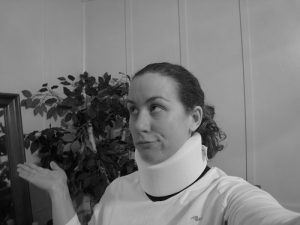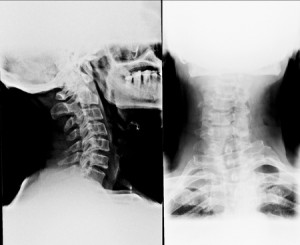What is Chiropractic Treatment of Whiplash?
To download a copy of this week’s newsletter, please click here.
Clear Lake City Chiropractor Comments: Whiplash is basically an injury to the muscles, the muscle attachments (tendons), ligaments, and sometimes the nerves that exit the cervical spine. The degree of injury is highly variable and depends on many factors, some of which include gender/body size (slender woman are especially at risk), awareness of the impending collision, head position at time of impact, the angle of the seat back (bent back is worse that upright), the position of the headrest (too low is common), the amount of vehicle damage (less damage can be worse due to energy transferred to the contents/occupants), the speed of the collision, and many others.

Therefore, when discussing the treatment approaches used by chiropractors, it is not appropriate to generalize since each case is so unique. With that said, when a whiplash patient visits a chiropractor, the first step is obtaining as much information as possible. A thorough history and examination are important in determining the treatment plan and help to determine severity of the injury. Chiropractors often offer different types of treatment that may include: manipulation, physical therapy modalities such as muscle stimulation, relaxation, ultrasound, low level laser therapy, cervical traction, and others. Spinal manipulation (often referred to as an adjustment) addresses joint dysfunction and can be performed with one of several approaches. The first and quite common approach uses a high velocity, low amplitude (quick) approach where joint cavitation (the “crack”) often occurs. Another approach is a low velocity, low amplitude technique where mobilization is used, which is more of a stretch to the end-range of intersegmental (between the vertebrae) motion and rarely, is there joint noise/cavitation.
Muscle relaxation or stimulation is performed for muscle dysfunction, which may include relaxation or stimulation techniques. Gentle stretches to a muscle that has excessive tightness or, repeated contractions of a weak (“inhibited”) muscle is also commonly utilized and very helpful when muscle dysfunction is present.
Exercises are frequently prescribed by chiropractors. These are taught in a supervised manner and when it is safely performed and understood, they can be performed at home, work, outside the office setting. It may require a few sessions to ensure accuracy of the exercise performance. Because of muscle spasm, joint dysfunction, and pain, patients often develop faulty postures or compromised movements that become “bad habits.” To break these “bad habit” positions/postures, stabilization and sensory-motor retraining exercises can be very helpful. These exercises retrain the nervous system to achieve better coordination and control movements and to maintain stability of the weakened neck muscles.
Advice on bend/lift/pull/push and/or work related activity is extremely important in order to avoid repeat exacerbations or “flare-ups” if not properly dwelt within the clinic. Advice on recreational and home related activities is also very important for the same reasons.
The chiropractic whiplash treatment plan is unique for every individual person given the significant number of variable initially discussed. One or more of the approaches discussed may be utilized. If needed, chiropractors often partner with other doctors if there are medication or surgical requirements. If you, a loved one, or a friend is struggling with whiplash residuals from a motor vehicle collision, you can depend on receiving a multi-dimensional chiropractic assessment and therapeutic approach at this office. We sincerely appreciate your confidence in choosing our office for your health care needs!
Dr. Ward Beecher practices at Beecher Chiropractic Clinic at 1001 Pineloch, Ste 700 Houston, TX 77062. You can schedule an appointment with the best chiroprator in Houston or by calling (281) 286-1300. If you have any questions regarding this blog, please comment below!
Whiplash: Where Is My Neck Pain Coming From?
To download a copy of this newsletter, please click here.
Houston Chiropractic Doctor Comments: Last week while driving to work, you’re stopped at a red light and glance in the rearview mirror and notice that a car is approaching from behind way too fast. The next thing you remember is the squeal of the tires and a loud crash with an accompanied sudden jolt as your car is propelled forward by the impact. Your initial reaction is one of shock, wondering is anyone hurt? How bad is my car damaged? Will there be another hit? Should I get out of the car? I’m going to be late for work! Within a few minutes, the police arrive and after about an hour of taking statements from the two drivers and a few witnesses, you decline an ambulance offer to take you to a nearby hospital for an examination as, “…this little stiffness and ache in my neck is no big deal.” Happy you can still drive your car, you arrive at work an hour and a half late. After reviewing the details of the crash with co-workers several times, you begin to notice a headache, your neck stiffening up and movements becoming limited and painful. After another couple of hours and a few Ibuprofen, the neck pain has increased and you now have a whopping headache. You decide, “I better go see my chiropractor to see if something is wrong.”
After the exam and x-rays, the chiropractor shows you a chart and explains the mechanism of injury that usually occurs in a low  speed rear-end collision. A couple of things that were said really hit home in helping you to understand how such a seemingly minor crash can create so much pain. The first is that it is not possible to voluntarily contract a muscle quick enough and “brace” to prevent the acceleration of the head. Upon impact, as the car is propelled forwards, the head initially goes backwards and then when the muscles in front of the neck are stretched to their limits, the head is then “whipped” forwards in a “crack the whip” type of response and all of this takes less than 600-700 milliseconds! Because of the far limits of neck motion being reached during this process, the ligaments that hold the vertebra together are often stretched and/or torn. This can be appreciated on the bending neck x-rays which shows one vertebra sliding forwards on the one below and the angle created being greater when compared to the surrounding vertebra. The second point of discussion that stands out was the fact that your head was rotated at the time of impact from looking in the rearview mirror places the neck at a greater risk of injury because of the twisting motion that occurs during the “crack the whip” process. Another interesting point: because there wasn’t a lot of car damage, the shock and force of the impact was not absorbed by crushing metal and that energy is therefore transferred to the contents in the vehicle, including the occupants. That is why your briefcase ended up on the floor and your glasses flew off during the crash. Another point of discussion was made concerning the difference between genders and the degree of injury, as women are more likely to be injured more severely because of the less muscular and sometimes longer female neck. The degree of injury is also at greater risk when there is osteoarthritis in the neck that pre-exists the crash. An analogy of how a young sapling branch can bend without breaking verses the “old oak branch” which snaps and breaks when its only bent slightly. So, if you are a middle aged, female with a long slender neck with pre-existing arthritis looking in the rearview mirror prior to impact in a rear-end collision, ligament over stretching / tearing is highly probable.
speed rear-end collision. A couple of things that were said really hit home in helping you to understand how such a seemingly minor crash can create so much pain. The first is that it is not possible to voluntarily contract a muscle quick enough and “brace” to prevent the acceleration of the head. Upon impact, as the car is propelled forwards, the head initially goes backwards and then when the muscles in front of the neck are stretched to their limits, the head is then “whipped” forwards in a “crack the whip” type of response and all of this takes less than 600-700 milliseconds! Because of the far limits of neck motion being reached during this process, the ligaments that hold the vertebra together are often stretched and/or torn. This can be appreciated on the bending neck x-rays which shows one vertebra sliding forwards on the one below and the angle created being greater when compared to the surrounding vertebra. The second point of discussion that stands out was the fact that your head was rotated at the time of impact from looking in the rearview mirror places the neck at a greater risk of injury because of the twisting motion that occurs during the “crack the whip” process. Another interesting point: because there wasn’t a lot of car damage, the shock and force of the impact was not absorbed by crushing metal and that energy is therefore transferred to the contents in the vehicle, including the occupants. That is why your briefcase ended up on the floor and your glasses flew off during the crash. Another point of discussion was made concerning the difference between genders and the degree of injury, as women are more likely to be injured more severely because of the less muscular and sometimes longer female neck. The degree of injury is also at greater risk when there is osteoarthritis in the neck that pre-exists the crash. An analogy of how a young sapling branch can bend without breaking verses the “old oak branch” which snaps and breaks when its only bent slightly. So, if you are a middle aged, female with a long slender neck with pre-existing arthritis looking in the rearview mirror prior to impact in a rear-end collision, ligament over stretching / tearing is highly probable.
In summary, it is important to obtain prompt evaluation and treatment by your chiropractor as soon as possible as when time passes without treatment, it is more difficult to bring about a reduction of pain and increased motion and, it will generally take longer. Taking medication for pain only postpones the needed process of restoring movement and function of the neck so that should not be the only treatment. In general, a “wait and watch” approach is not wise in these types of injuries. If you or a loved one is suffering with whiplash, sharing this information may be one of most significant acts of kindness that you can give to those that you care about.
Dr. Ward Beecher practices at Beecher Chiropractic Clinic at 1001 Pineloch, Ste 700 Houston, TX 77062. You can schedule an appointment at BeecherChiropractic.com or by calling (281) 286-1300. If you have any questions regarding this blog, please comment below!
Minimizing Your Whiplash Risk
Houston Area Chiropractor Comments: While it is hard to prevent someone from crashing their car into your car, there are some things you can do to minimize whiplash injuries.
The first preventive measure is making sure your seat is upright and the head rest touches the top of your head. If there is a lot of distance between your head and the rest, it will do little to help in the event of a collision. Also, if the headrest is too low, in can act as fulcrum, leveraging your neck into a worse position, and increasing injury risk.
Another thing we can do minimize injury risk is being in the best possible shape prior to the trauma. Research has shown people with good aerobic fitness seem to be more resilient after whiplash accidents.
If you are aware you are about to be hit, it is probably best to remain in a neutral position with eyes facing forward. People with their head turned prior to impact seem to have worse ligament injuries.
If you can afford it, a larger car will lessen the momentum of your vehicle after a collision. There are now vehicles with whiplash-protection seats (e.g. Saab) that dampen the effects of rear end-accidents. Frontal collisions tend to be less severe to the neck if the speeds are equal because the chin can hit the chest preventing forward motion of the neck. Rear-end and side-impact collisions do not have this benefit.
Unfortunately, there are many simply unavoidable risk factors. Women and children seem to be more vulnerable, possibly because of the increased head to neck size ratio. Also if you’ve ever had a head or neck trauma before and or have a degenerated disk in the neck, these factors elevate your risk for a more pronounced injury. Other factors that can slow your recovery include wearing a neck brace/collar, taking to bed rest, or getting vertical traction treatments. Inhibiting movements can feel good initially but is not good in the long term because of decreased muscle function and strength. Getting diagnosed as soon as possible can determine the best course of action for getting you to back to a speedy recovery. Just letting things go is rarely a good solution.
Dr. Ward Beecher practices at Beecher Chiropractic Clinic at 1001 Pineloch, Ste 700 Houston, TX 77062. You can schedule an appointment at BeecherChiropractic.com or by calling (281) 286-1300. If you have any questions regarding this blog, please comment below!
Whiplash and Balance
To download a copy of this newsletter, please click here.
Clear Lake City Doctor of Chiropractic comments: As whiplash injuries are studied more and more, the  many health problems that can develop as a result of them are becoming more apparent. Neck sprains are not simple problems like a sprained ankle because the neck is involved in a lot of important duties, not just movement. One such function of the neck is to keep you upright and in balance. Balance is complex and involves coordination between sensations in your inner ear, your eye movements and neurological signaling from your neck, spine and legs. The neck nerves are especially important in this regard. The brain receives inputs from the ears, the eyes, and neck, and determines from these three areas where you are in space, where’ve you been, and where you are going. If any of these areas is affected, then balance is disturbed.
many health problems that can develop as a result of them are becoming more apparent. Neck sprains are not simple problems like a sprained ankle because the neck is involved in a lot of important duties, not just movement. One such function of the neck is to keep you upright and in balance. Balance is complex and involves coordination between sensations in your inner ear, your eye movements and neurological signaling from your neck, spine and legs. The neck nerves are especially important in this regard. The brain receives inputs from the ears, the eyes, and neck, and determines from these three areas where you are in space, where’ve you been, and where you are going. If any of these areas is affected, then balance is disturbed.
You may stumble around more, not really have a sense of where your feet are; you may trip more and in severe cases, you may develop vertigo (a spinning sensation). These symptoms can have a devastating effect on your quality of life, even resulting in nausea.
A study from Europe (funded by an insurance company) (Coll Antropol 2007;31:823) looked at how we sense position of the head following whiplash. The researchers compared whiplash-injured patients to normal healthy people in their ability to sense the position of their head; whether they were rotated or tilted in some way. The results were alarming. Patients with cervical spine injury showed significant impairment of proprioception (sense of position)
Chiropractic care involves trying to normalize joint function of the neck. Adjustments are designed to restore normal mobility and improve the posture of the neck so that it is more balanced. Some patients will need specific exercises, even balance therapy, to help improve their sense of position and keep them from feeling dizzy.
So if you’ve wondered about feeling unsteady, or are not really sure on your feet, this could be a consequence of a whiplash injury. Because both the brain and neck can be injured in whiplash, the symptoms can be quite substantial. Just letting it go and hoping it will go away can create an even longer lasting problem. And bed rest or simply not moving the neck are not good options either, because your neck needs to move to properly heal. Some neck collars can even create more of a problem leading to muscle weakness. They are right for some patients, but not for everyone.
Our clinic specializes in a comprehensive rehabilitation program to help you get past the whiplash injury, and back to the normal quality of life you enjoyed before the trauma.
Dr. Ward Beecher practices at Beecher Chiropractic Clinic at 1001 Pineloch, Ste 700 Houston, TX 77062. You can schedule an appointment at BeecherChiropractic.com or by calling (281) 286-1300. If you have any questions regarding this blog, please comment below!

